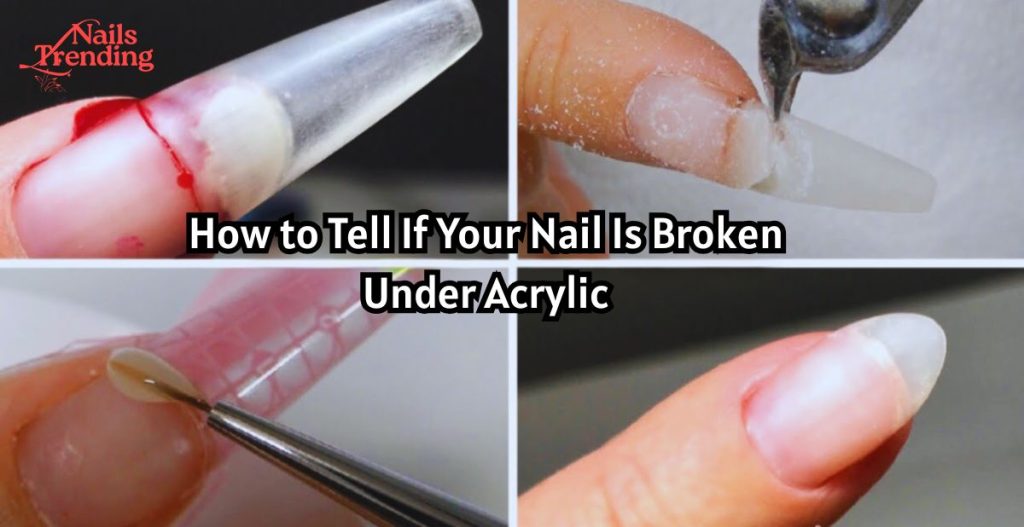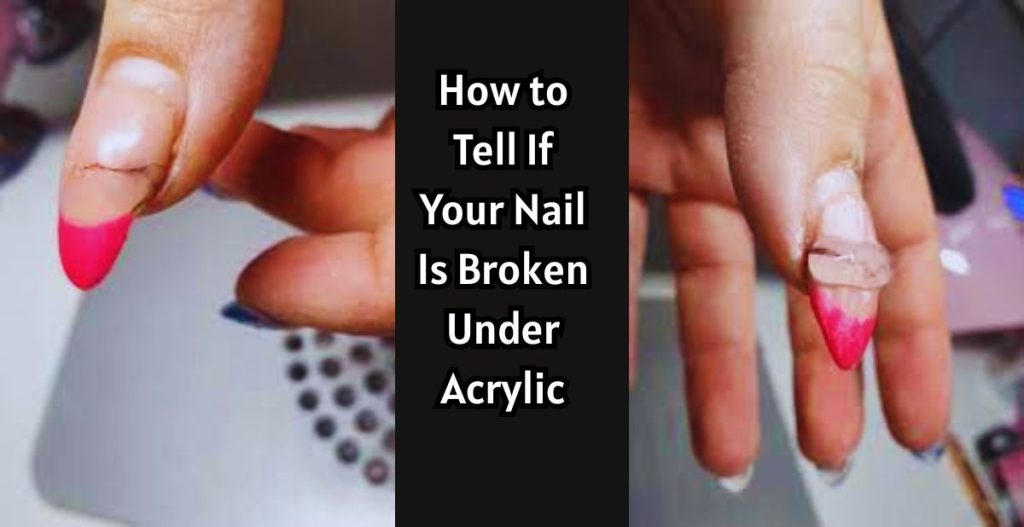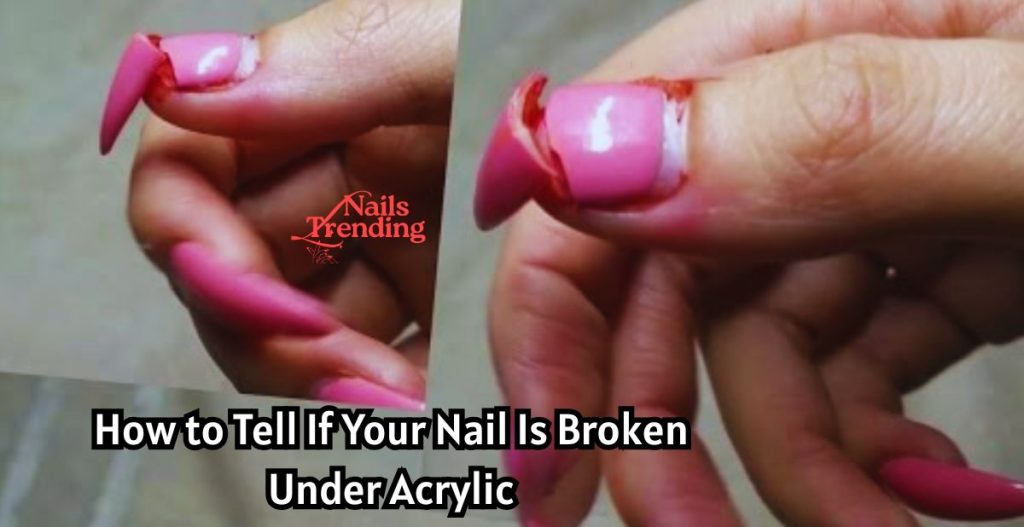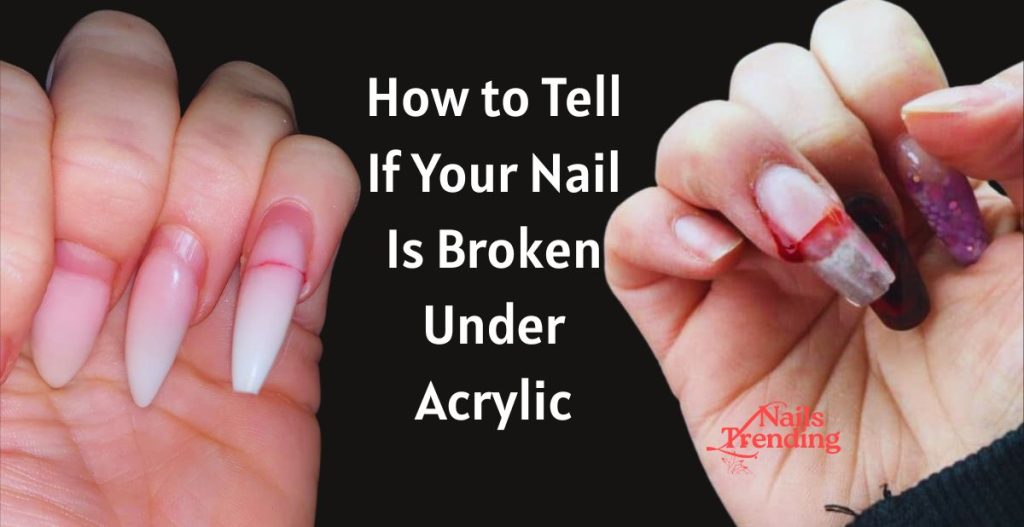As an Amazon Associate I earn from qualifying purchases.
You just bumped your hand, and now your acrylic nail is throbbing. But is it just the acrylic, or is your real nail actually broken underneath? Knowing how to tell if your nail is broken under acrylic can make all the difference between a quick fix and a painful infection.
Acrylic nails are stunning, but they can sometimes hide damage beneath the surface. Because the artificial layer is hard and opaque, it’s not always easy to see what’s going on underneath — especially when you feel that sharp sting or pulsing ache after hitting your hand.
Ignoring early signs of a broken natural nail can lead to swelling, bleeding, or even permanent nail bed damage. That’s why learning to recognize the difference between minor acrylic discomfort and an actual nail injury is essential. In this guide, we’ll break down how to spot a broken nail under acrylic, what symptoms to watch for, and how to treat it safely at home (or when to call a professional).
By the end, you’ll know exactly how to:
- Identify the signs of a nail injury beneath acrylic
- Relieve pain and prevent infection
- Treat your nail properly for a healthy regrowth
Let’s dive into the key signs that your nail may be broken — and how to deal with it before it gets worse.
How to Tell If Your Nail Is Broken Under Acrylic
When you wear acrylic nails, it can be tricky to know what’s really happening underneath that polished surface. But your body has a way of signaling that something’s wrong — and recognizing those signs early can save you from bigger problems like infection or nail loss. Here’s how to tell if your nail is broken under acrylic:
Pain or Pressure Sensation
If you feel sharp, throbbing, or constant pain, that’s one of the clearest signs your natural nail may be injured. A cracked nail bed or split nail plate can create pressure between the acrylic and the real nail, causing intense discomfort. Unlike mild soreness after application, this kind of pain doesn’t fade over time — it often gets worse when you touch or tap the area.
Discoloration
Take a close look at the nail surface. If you notice red, purple, or dark spots under the acrylic, it could mean bleeding beneath the nail — a common result of trauma. This is sometimes called a subungual hematoma, where blood pools between the nail bed and the acrylic. The color may darken over time, signaling deeper damage.
Lifting or Separation
When your acrylic starts lifting unevenly or feels loose on one side, it could be more than a bad glue job. A natural nail that’s cracked or partially detached often causes the acrylic to lift, creating a small gap where bacteria and moisture can collect — the perfect setup for infection.
Swelling or Warmth
If your fingertip feels puffy, warm, or tender, that’s your body responding to inflammation. The area around the nail may turn slightly red or appear shiny. These symptoms suggest your body is trying to heal a wound — and that there may be an infection forming under the acrylic.
Bleeding or Fluid Leakage
Any visible blood, clear fluid, or pus near the cuticle or under the edge of your nail is a strong indicator that the nail is broken or torn. Fluid leakage means the skin or nail bed has been compromised. At this stage, it’s best to remove the acrylic and seek proper care to avoid bacterial growth.
Personal Insight:
Once, after catching my acrylic nail on a drawer handle, I brushed it off thinking it was just a bad snag. But the pain didn’t fade even after several hours — it throbbed constantly and felt hot to the touch. When I finally removed the acrylic, I found that my real nail had split right down the middle. That experience taught me that if the pain lingers, it’s usually a sign your nail is truly broken underneath.

What to Do If You Think Your Nail Is Broken Under Acrylic
If you suspect your nail is broken under an acrylic, the worst thing you can do is panic or rip it off. Acting calmly and carefully can save your natural nail from further damage and help it heal faster. Here’s a step-by-step guide on what to do the right way:
Don’t Pull Off the Acrylic
It might be tempting to remove the acrylic nail right away, but doing so can tear your natural nail even more. The adhesive is strong, and pulling it can worsen the break or cause bleeding. If the acrylic feels tight or painful, leave it in place until it can be properly soaked off.
Trim or File Down the Acrylic (Only If It’s Loose)
If the acrylic has already started lifting or feels unstable, you can gently file down the edges or trim the tip using sanitized nail clippers. This helps prevent accidental snagging on clothes or hair, which can cause more pain and damage. Be gentle — you’re just trying to reduce pressure, not fully remove it yet.
Soak in Warm, Soapy Water
Prepare a bowl of warm water with mild soap or Epsom salt and soak your finger for 10–15 minutes. This will help reduce swelling, ease discomfort, and soften any dried blood or debris around the nail. It’s also soothing and helps you assess the damage more clearly afterward.
Disinfect Gently
After soaking, pat your hand dry with a clean towel and apply a gentle antiseptic, like hydrogen peroxide or an alcohol-free disinfectant. This helps prevent infection, especially if there’s any bleeding or open skin. Avoid harsh alcohol wipes — they can sting and irritate the area.
Apply a Breathable Bandage
Once the area is clean, cover it with a light, breathable bandage or gauze wrap. This protects the nail from further trauma and reduces the risk of snagging. Change the bandage daily, and keep the area dry and clean.
Visit a Nail Tech or Doctor if Symptoms Worsen
If you notice increasing pain, redness, swelling, or warmth, it’s time to seek help. A licensed nail technician can safely remove the acrylic using proper tools, while a doctor or dermatologist can check for infections or severe breaks that might need medical treatment. Never try to dig out or pry off the nail yourself — it can make things much worse.
Quick Tip:
If your nail feels too painful to touch or looks dark under the surface, avoid applying pressure or polish. Let a professional examine it — sometimes, what looks like a simple bruise could actually be a deeper nail bed injury.
How to Treat a Broken Nail Under Acrylic (Safely at Home)
If you’ve discovered your nail is broken under acrylic, don’t worry — not every case requires a salon or doctor visit. With the right care and patience, you can treat a minor break safely at home and help your nail recover naturally. Here’s how to handle it based on the severity of the damage:
If the Break Is Minor
When the break is small — such as a light crack or split near the edge — you can usually manage it yourself.
- Gently file down any jagged edges to prevent the crack from spreading.
- Apply a thin layer of nail glue or repair resin over the break to hold it together and protect the area from moisture.
- Cover with a silk wrap or a small patch of tea bag paper if you want extra reinforcement.
- Avoid using your hands for heavy tasks for a few days — the less stress on the nail, the better it heals.
If It’s Painful or Bleeding
If your nail is throbbing, bleeding, or feels hot, skip the glue completely. You don’t want to trap bacteria under a sealed layer.
- Clean the area with warm, soapy water and disinfect gently using an antiseptic or hydrogen peroxide solution.
- Pat it dry, then apply an antibiotic ointment if available.
- Cover it with a light bandage or gauze to keep it protected from further bumps or infection.
- Keep it clean and dry until the bleeding stops and tenderness subsides.
Moisturize and Strengthen During Healing
Once the pain and swelling go down, focus on restoring nail health and encouraging regrowth.
- Massage your nails and cuticles with cuticle oil, coconut oil, or vitamin E daily to improve circulation.
- Take biotin supplements or eat biotin-rich foods like eggs, salmon, and almonds — they can help your nail grow stronger and faster.
- Avoid wearing acrylics or gel polish until the nail has completely healed and feels strong again.
When to See a Professional
Sometimes, a nail injury can go beyond a simple crack. If you experience:
- Persistent throbbing pain
- Pus, foul odor, or yellow-green discharge
- Dark discoloration under the nail
- The nail lifting entirely from the nail bed
…it’s time to visit a doctor or dermatologist. You may have an infection or deeper nail bed trauma that requires professional care.
Pro Tip:
Don’t rush the healing process. Even a small break can take a few weeks to recover fully. Treat your hands gently, keep them moisturized, and let your natural nail rebuild its strength before getting a new acrylic set.

Why Does My Nail Hurt Underneath Acrylic?
If your nail hurts underneath acrylic, it doesn’t always mean it’s broken — though that’s one possible cause. Pain under acrylic nails can come from several issues related to application, maintenance, or hygiene. Here are the most common culprits:
1. Over-Filing the Nail Bed Before Application
Some nail technicians file the natural nail too aggressively before applying acrylic. This thins out the nail plate, leaving it sensitive and vulnerable. When the acrylic hardens on top, that thin nail bed can’t handle the pressure, leading to soreness or even small cracks.
2. Acrylic Too Thick or Tight
If the acrylic is applied too thickly or pressed down too tightly, it can create constant pressure on the natural nail. As your nail grows, that pressure intensifies, making it painful or uncomfortable — especially when you bump your hand or grip something.
3. Bacterial or Fungal Infection
Moisture trapped between the acrylic and your natural nail is the perfect environment for bacteria or fungus to grow. This can cause redness, swelling, throbbing, or a greenish tint under the acrylic. Once infection sets in, the pain can become sharp and persistent.
4. Old or Lifting Acrylics
As acrylic nails grow out, they can begin to lift away from the nail plate, creating tension where the bond weakens. This lifting pulls at your natural nail, especially when water or air gets underneath, leading to pain or pressure that doesn’t go away until it’s refilled or removed.
How to Relieve Acrylic Nail Pain Quickly
If you’re dealing with pain from your acrylics, here are simple, effective ways to find relief fast:
- Apply a Cold Compress: Wrap ice in a clean towel and apply for 10–15 minutes to reduce swelling and numb the area.
- Take Over-the-Counter Pain Relievers: Medications like ibuprofen or acetaminophen can help relieve inflammation and soreness.
- Keep Your Hand Elevated: Lifting your hand slightly above heart level helps ease blood pressure in the injured area and reduces throbbing.
- Avoid Tight Gloves or Pressure: Don’t wear anything that squeezes or presses on the sore nail until it heals completely.
- Limit Water Exposure: Keep the area dry to prevent bacterial buildup and further irritation.
Prevention Tips — Protecting Your Natural Nails Under Acrylics
Healthy nails start with good habits. Here’s how to protect your natural nails while still enjoying your acrylics:
- Choose a Reputable Nail Technician: A trained professional knows how to prep the nail without over-filing or damaging the nail bed.
- Give Your Nails “Rest Days”: Take breaks between acrylic sets so your nails can breathe, rehydrate, and regain strength.
- Keep Nails Dry and Clean: Avoid prolonged moisture exposure — water trapped under acrylics is a leading cause of infection.
- Use Cuticle Oil Regularly: Hydrating your nails keeps them flexible, reducing the risk of cracks or lifting.
Personal Tip:
“I’ve learned to schedule short acrylic breaks every few months — my nails grow back healthier and stronger every time.”
My Acrylic Nail Is Lifting and It Hurts — What It Could Mean
If your acrylic nail is lifting and causing pain, it could signal one of two things:
- A crack or break in the natural nail underneath, or
- A bacterial or fungal infection beginning to develop.
Whatever you do, don’t glue it back down — that only traps bacteria under the surface and makes things worse. Instead, keep it clean and dry, and if possible, have it professionally removed. A licensed technician can safely soak off the acrylic and inspect the nail bed for damage.
When to See a Doctor or Nail Professional
Sometimes, home care isn’t enough. It’s best to get professional help if you notice any of the following:
- Pain that doesn’t subside after 24–48 hours
- Nail turning black, green, or purple
- Swelling, pus, or foul odor around the nail
- Nail lifting completely or flapping loosely
These signs often point to an infection or severe nail trauma, both of which require prompt treatment to avoid long-term nail damage.

FAQs
Q1: How do I know if my real nail is broken under acrylic?
If you feel sharp or throbbing pain, see red or purple discoloration, or notice that your acrylic is lifting unevenly, your real nail might be cracked or bleeding underneath. Persistent pain or pressure is usually a sign that the natural nail has been injured.
Q2: What should I do if my acrylic nail is lifting and it hurts?
Avoid pulling it off — that can make things worse. Instead, trim it short if possible, clean the area with antiseptic, and keep it protected with a bandage. If the pain, redness, or swelling continues, visit a licensed nail technician or doctor for safe removal and treatment.
Q3: How do I relieve pain from a nail broken under acrylic?
Apply a cold compress to reduce swelling, soak your finger in warm water for comfort, and take ibuprofen or acetaminophen to relieve pain and inflammation. If discomfort lasts more than a day or two, seek professional care — it could indicate an infection or deeper injury.
Q4: Can I still wear acrylics if my natural nail is damaged?
No — it’s best to let your nail heal completely first. Covering a damaged nail with acrylic traps bacteria, delays recovery, and can make the injury worse. Allow your nail to regrow naturally before applying another set.
Q5: Why does my nail hurt under acrylic even if it’s not broken?
Pain can come from over-filing, tight acrylic application, or moisture trapped underneath. These can irritate your nail bed or cause minor inflammation. If the soreness doesn’t fade, have the set checked by a professional.
Q6: Can a broken nail under acrylic heal on its own?
Minor breaks can heal naturally within a few weeks if kept clean, dry, and protected. However, severe cracks or infections need professional attention to prevent scarring or permanent nail damage.
Q7: What happens if you ignore a broken nail under acrylic?
Ignoring it can lead to infection, nail detachment, or long-term damage to the nail bed. Early care is crucial — disinfect the area, bandage it, and monitor for signs of swelling or pus.
Q8: How can I prevent nail pain from acrylics in the future?
Choose a qualified nail tech, avoid over-filing, keep nails hydrated with cuticle oil, and take breaks between sets. Regular maintenance helps prevent lifting, pressure, and painful breaks.
Final Thoughts
Nail accidents happen to everyone — even the most careful among us. Whether it’s a snag, a bump, or just poor timing, a broken nail under acrylic can be painful but manageable with the right care.
The key is to act quickly, stay gentle, and listen to your body. Pain isn’t just an inconvenience — it’s your body’s way of telling you something’s wrong. Treat the area with care, keep it clean, and don’t hesitate to seek professional help if things don’t improve.
With a little patience and the right approach, your natural nail will heal beautifully, and you’ll be ready to enjoy your next set of acrylics safely and confidently.
Amazon and the Amazon logo are trademarks of Amazon.com, Inc, or its affiliates.







